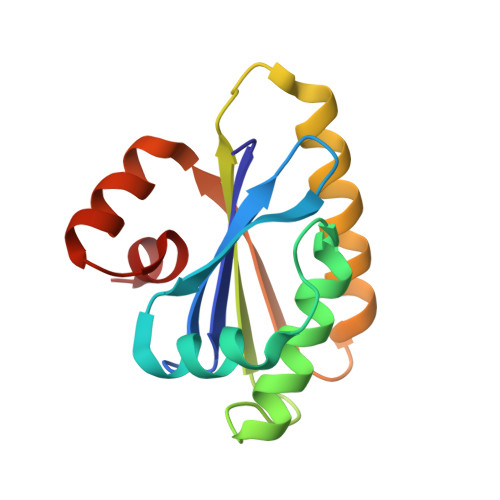Bacterial SEAL domains undergo autoproteolysis and function in regulated intramembrane proteolysis.
Brogan, A.P., Habib, C., Hobbs, S.J., Kranzusch, P.J., Rudner, D.Z.(2023) Proc Natl Acad Sci U S A 120: e2310862120-e2310862120
- PubMed: 37756332
- DOI: https://doi.org/10.1073/pnas.2310862120
- Primary Citation of Related Structures:
8T9N - PubMed Abstract:
Gram-positive bacteria use SigI/RsgI-family sigma factor/anti-sigma factor pairs to sense and respond to cell wall defects and plant polysaccharides. In Bacillus subtilis, this signal transduction pathway involves regulated intramembrane proteolysis (RIP) of the membrane-anchored anti-sigma factor RsgI. However, unlike most RIP signaling pathways, site-1 cleavage of RsgI on the extracytoplasmic side of the membrane is constitutive and the cleavage products remain stably associated, preventing intramembrane proteolysis. The regulated step in this pathway is their dissociation, which is hypothesized to involve mechanical force. Release of the ectodomain enables intramembrane cleavage by the RasP site-2 protease and activation of SigI. The constitutive site-1 protease has not been identified for any RsgI homolog. Here, we report that RsgI's extracytoplasmic domain has structural and functional similarities to eukaryotic SEA domains that undergo autoproteolysis and have been implicated in mechanotransduction. We show that site-1 proteolysis in B. subtilis and Clostridial RsgI family members is mediated by enzyme-independent autoproteolysis of these SEA-like domains. Importantly, the site of proteolysis enables retention of the ectodomain through an undisrupted β-sheet that spans the two cleavage products. Autoproteolysis can be abrogated by relief of conformational strain in the scissile loop, in a mechanism analogous to eukaryotic SEA domains. Collectively, our data support the model that RsgI-SigI signaling is mediated by mechanotransduction in a manner that has striking parallels with eukaryotic mechanotransducive signaling pathways.
- Department of Microbiology, Harvard Medical School, Boston, MA 02115.
Organizational Affiliation:
















